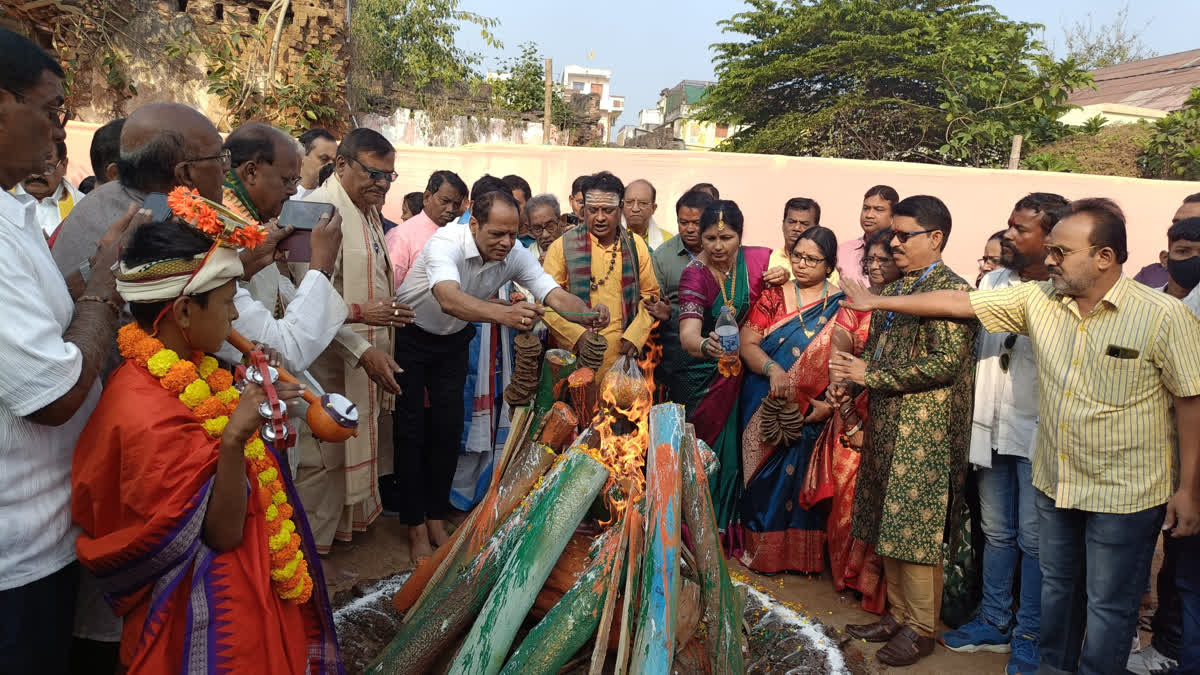Berhampur (Odisha) : Before the clock struck midnight, M. Chandrakala was busy arranging things and rushing from one side of the house to another to ensure all the requirements for the rituals have been looked into. Even in the rush, she had not forgotten to invite her neighbours - mostly Odia families - to come over for the celebrations and feasting. All her family members wore new clothes and she, draped in a Kanjeevaram saree, flowers in the hair and decked in heavy gold ornaments, was all set for celebrations. Soon people kept trickling to her house and the community was together to celebrate unitedly. Welcome to Bhogi, a festival that has started defining the character of the Silk City Berhampur.
The celebrations were not limited to a house or two like that of Chandrakala's, but every house in the city, where Telugu-speaking families make up over 40% of the population, seemed to be immersing in the vibrant celebrations.
The four-day fete, which ushers in Makar Sankranti, is a highly celebrated occasion marked by lighting the Bhogi fire, preparing traditional dishes like khiri (porridge) made from new rice, and paying homage to ancestors. Cultural programmes, rituals, and communal feasts further add to the festive spirit.
Bhogi Celebrations Unite Odia And Telugu Communities In Berhampur (ETV Bharat) This year too celebrations began in a grand way with families indulging in lighting Bhogi fires and performing pujas late into the night on Monday. The Vogipalu ritual, aimed at protecting children from negative influences, marked the first ritual. “We look forward to this festival all year—it’s a time to reconnect with loved ones and our roots,” shared Chandrakala.
Four Days of Festivities
Bhogi marks the beginning of a series of celebrations that include Pongal, Kanumu, and Mukanumu. Each day carries its own significance:
• Day 1 (Bhogi): Families gather to light fires, burn cow dung balls, and offer prayers to Lord Krishna.
• Day 2 (Pongal): A day of thanksgiving, Pongal involves paying respects to ancestors and preparing offerings of rice and jaggery.
• Day 3 (Kanumu): Dedicated to animals and birds, this day highlights the community’s agricultural roots.
• Day 4 (Mukanumu): Families come together for a joyous feast, marking the end of the celebrations.
Bhogi Celebrations Unite Odia And Telugu Communities In Berhampur (ETV Bharat) Rooted in Telugu traditions, Bhogi has made inroads into the Odia families in Berhampur. The festival fosters a sense of brotherhood, as families from both communities join hands to celebrate. “In Berhampur, all of us celebrate the festival with gusto. This occasion marks a cultural exchange and we all like to share our traditions with each other. Bhogi thus helps us unite,” said R. Murali Mohan, President of Berhampur Urban Cooperative Bank.
Cultural Extravaganza
Apart from the rituals during the four day festival, cultural programmes add to the excitement. This year, the Andhra Bhasha Vivardhani Samaj and the Telugu Bhasha and Cultural Association arranged music, dance, and community performances. A special gathering at Nilakanthanagar Saraswati Sishu Vidya Mandir brought together people from all walks of life, including Berhampur MP Pradeep Panigrahi and Mayor Sanghamitra Dalai.
Bhogi Celebrations Unite Odia And Telugu Communities In Berhampur (ETV Bharat) A Festival of Warmth and Wellness
An important part of the festivities including lighting community bonfire and dancing around it. Also important is the tradition of burning kandamul (sweet potato and other vegetables) in the Bhogi fire. Locals believe this practice helps ward off winter ailments. The elderly present at the bonfire corroborate this. "Consuming this burnt vegetable cures many ailment and gives immunity from various winter diseases," they said in unison.
The festival is mostly celebrated in areas like Badabazar, Sanbazar, Premnagar, Khalasi Sahi, Baguli Sahi and Bachuari Sahi, where Odias and Telugus enjoy wearing new clothes.
For Odia families, Makar Sankranti holds equal significance for it marks the offering of new rice to the Sun God in the form of Makara Chaula. Made up with raw rice, which is soaked and broken into pieces, banana, jaggery, sugarcane, sugar and coconut scrapings are added to it and offered to the Sun God.
Speaking about the relevance and importance of the festival, Corporator of the Berhampur Municipal Corporation T Kishore said, "It is mainly celebrated in South India, Tamil Nadu, Karnataka, Andhra Pradesh, Telangana and Odisha, while people living abroad come to their homes during this festival and immerse in the celebrations."
Known as Pongal in Tamil Nadu, Lohri in Punjab, and Bihu in Assam, on Makar Sankranti, the sun changes direction from south to north, marking the end of winter and the beginning of spring. This change in direction is called Uttarayan, which means "northward movement" in Sanskrit.
Read More
